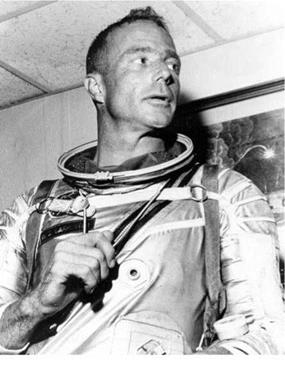MERCURY ATLAS 7
 1962 tau 1 24 May 1962
1962 tau 1 24 May 1962
Pad 14, Cape Canaveral, Florida 24 May 1962
Northeast of Puerto Rico, Atlantic Ocean Atlas 107D; spacecraft serial number SC-18 4hrs 56 min 5 sec Aurora 7
Three-orbit mission
Flight Crew
CARPENTER, Malcolm Scott, 37, USN, pilot
Flight Log
Mercury Atlas 7, which was originally to have been the first manned orbital flight, was assigned to astronaut Deke Slayton (who would have used the call sign Delta 7), with Wally Schirra as his back-up. On 16 March 1962, it was announced that Slayton would be dropped from flight status because of a “heart flutter”, but his replacement was not Schirra but Glenn’s back-up, Scott Carpenter. This was mainly because Carpenter had more simulator training experience and MA7 was to be a three-orbit affair, like Glenn’s.
The mission – the first to be flown by a replacement astronaut – was also to be the first science flight, with experiments to study visibility from space, the behaviour of liquid in weightlessness, to take hand-held photos of weather patterns and the airglow phenomena, and to deploy a five-colour, 74 cm (29 in) diameter balloon extending on a tether about 30 m (98 ft) from the capsule, which Carpenter named Aurora 7 after his hometown street. In retrospect, the astronaut was given too much to do on the flight and as a result, fell behind the schedule, became a bit flustered and was impatient and careless. He was rather unfairly blamed by some fellow astronauts.
The flight began at 07: 45 hours at Cape Canaveral after being delayed three times, each for only 15 minutes, because ground fog would make launch monitoring and photography difficult. Carpenter reached 32.5° orbit, with an apogee of 267 km (166 miles) and a maximum speed of 28,242 kph (17,550 mph) and got to work. His spacesuit overheated, he had to make several manual orientation manoeuvres to correct the automatic control system, and before retro-fire he had not even read his pre-retro-fire checklist. While struggling to do three things at once, he inadvertently hit the roof of Aurora 7, discovering the source of Glenn’s “fireflies” as ice particles on the outside. He switched to manual control in preparation for the orientation manoeuvre and forgot to switch off the automatic system, wasting precious fuel.
|
Scott Carpenter, pilot of Mercury Atlas 7 |
The spacecraft was at the wrong yaw and pitch angle at retro-fire, which came three seconds late. Carpenter lost his orientation propellant during the re-entry. He gave a continuous, somewhat excitable commentary into a tape recorder during the re-entry and landed 400 km (249 miles) off target, northeast of Puerto Rico at T + 4 hours 56 minutes 5 seconds. He was spotted in a life raft 38 minutes after splashdown, but another two and a half hours elapsed before a helicopter from the USS Pierce picked him up, giving rise to public worries that he had been lost.
Milestones
6th manned space flight 4th US manned space flight 4th Mercury manned flight 1st flight by a replacement crew
On 17 July 1962, the first X-15 astro-flight to 95.9km (pilot Robert White, 38, USAF) was achieved using the number 3 aircraft.











